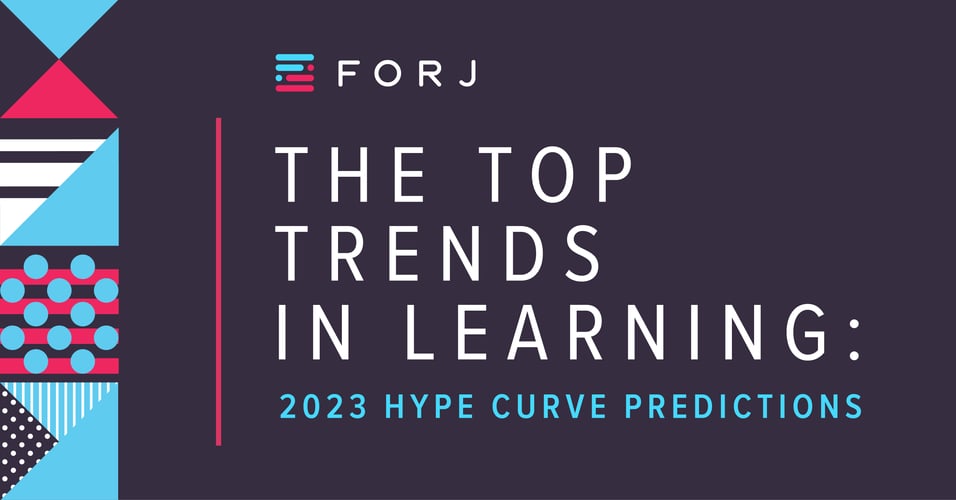
The Top Trends in Learning: 2023 Hype Curve Predictions

Each year, we examine trends to explore how learning has evolved and predict where it's likely to go in the future. The Learning Hype Curve is a visual representation of what's trending, built using the Gartner Hype Cycle theory. The theory holds that technologies emerge with little initial recognition and grow in familiarity until they reach their maximum "hype" at five points: Innovation Trigger, Peak of Inflated Expectations, Trough of Disillusionment, Slope of Enlightenment, and Plateau of Productivity.
In the past, we'd based our predictions about learning hype on data from learning influencers' Twitter feeds of a set of influencers in the Learning industry. The pandemic changed the way we connect and learn, so it also changed our approach to the hype curve.
Starting in 2021, instead of combing through Twitter feeds, we interviewed learning experts to get their take on rising trends. These interviews have allowed us to get up close and personal with the trending topics, hearing about trends straight from the source.
In 2022, we made a few more updates to the way we compile data and make predictions:
- We added data from LinkedIn! We've felt for years that many of the key conversations in our space were happening on LinkedIn, but for technical reasons, we were limited to Twitter content. We've now overcome the technological hurdles and added the last six years of LinkedIn posts from dozens of influencers to our dataset.
- The addition of many LinkedIn accounts to our list of influencers changed our historical data. If you're the type to go back and compare charts from this edition of the hype curve to past editions, you'll see the y-axis values (proportion of influencers using the word) have changed for individual words. That is because they now include LinkedIn data.
- Earlier versions of the hype curve included data back to 2017. To ensure consistency, we moved the start of the data forward to November 2018. Since our last full month of data is from October 2022, that gives us exactly four years of data represented in this report.
With that, let's explore the learning hype curve predictions for 2023.
Innovation Trigger & Emergent Technology
An Innovation Trigger is the point at which a new technology—or, in our case, a learning trend—emerges onto the scene. Only a few insiders are aware of the trend, but after emerging, it begins growing in popularity and familiarity.
In 2022, we saw four Innovation Triggers emerge: Metaverse, Hybrid Learning, Upskilling, and Employee Experience.
Innovation Trigger #1: Metaverse
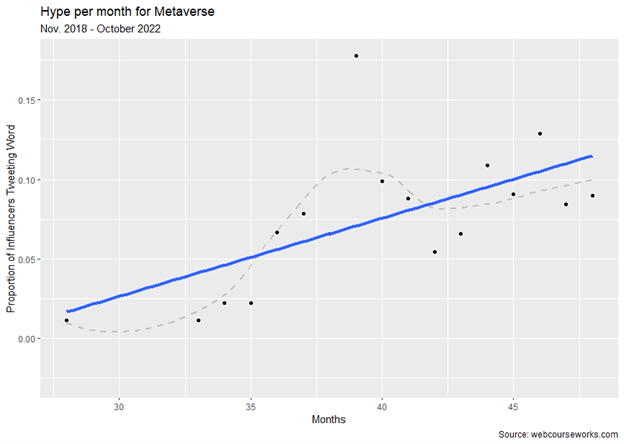
But we shouldn't equate the Metaverse as a concept to Mark Zuckerberg's rebranding of Facebook as Meta. The Metaverse actually refers to a set of technologies that exist "on top of" reality: augmented reality (AR), virtual reality (VR), and associated virtual worlds, platforms, and technologies. This is a point that influencers consistently make: Metaverse, the concept, does not equal Meta, the company.
Meta, the former Facebook, is a company developing products that add to an existing Metaverse that already includes technologies as diverse as Oculus VR (virtual reality) headsets, the longstanding virtual world Second Life, augmented reality (AR) games like Pokémon Go, and even online games your kids are playing, like Roblox.
A good article shared by influencer Brandon Carson on LinkedIn defines the Metaverse as a new way of interfacing with the internet via 3D motions (think of VR and AR interfaces), game engines (tools for building 3D worlds that originated in video game authoring and are now being applied for other purposes), in virtual worlds (e.g., Pokémon Go, Second Life), and in virtual economies (NFTs, blockchain, crypto). In that expansive definition, it's difficult to see how the Metaverse will not affect online learning. We've already seen examples of SCORM vendors using game engines like Unity to build 3D experiences, and we've been talking about games as learning tools for decades.
Innovation Trigger #2: Hybrid Learning
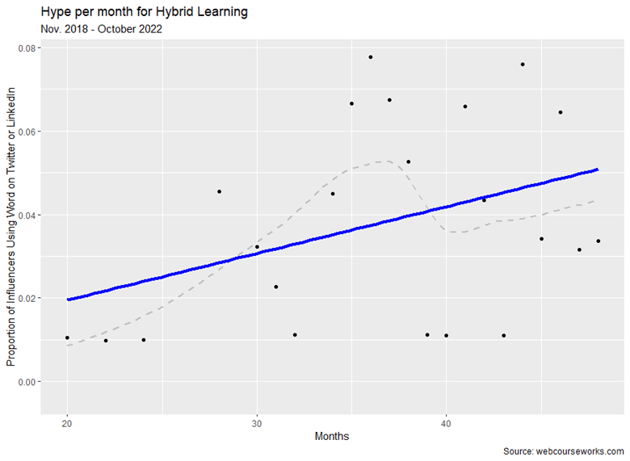
If you look carefully at the x-axis of our plot, you'll see the first dot occurs at month 20. That means for the first 20 months of the dataset—November 2018 to June 2020—we don't have the term "hybrid learning" in our dataset at all. In other words, hybrid learning took off right around the time people began emerging from the deepest part of pandemic lockdown. As people started to experience "hybrid work" in the "hybrid workplace," our influencers started to talk about hybrid learning.
However, unlike many pandemic-specific buzzwords, hybrid learning continues to grow. That makes sense. Hybrid learning typically refers to a mix of online and in-person modalities. It got a boost from the pandemic, perhaps displacing the very similar concept of blended learning. Then, it stuck around because it's an appealing option for both people and organizations.
As a learner, there are some things I want to study at the computer or on my own, and some that I want to get in a room and work on with people. Similarly, organizations like to provide learning experiences that are partly self-study, partly instructor-led because that approach reduces scheduling headaches and allows them to offer an in-person experience while saving on scarce instructor resources.
Innovation Trigger #3: Upskilling
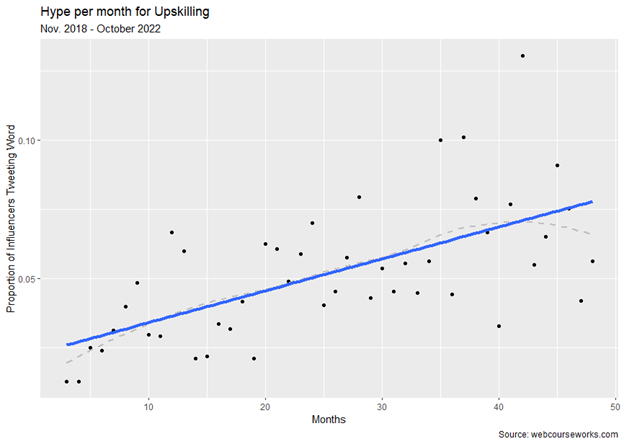
Upskilling is a workplace trend on the rise—and with good reason. It refers to training and development that expands people's skill sets, often with programs targeted to the most in-demand skills. Upskilling offers organizations a way to optimize their existing talent and invest in their people.
The concept itself may have first emerged as a trend during and immediately following the pandemic when we saw dramatic shifts in the labor market and companies were in desperate search of solutions to the talent shortage. In 2022, the influencers in our data set were talking about upskilling in a new context—specifically seeking learning design and software solutions to help advance their learning strategies.
They also called attention to the organizations doubling down on upskilling. Google is just one example. As they increased the availability of courses and certificates for the general public, there were, in effect, upskilling an entire labor force. Similarly, CompTIA—an association that issues certifications in IT—became so busy certifying people that they hired 100 new instructors to support the delivery of their courses.
Innovation Trigger #4: Employee Experience
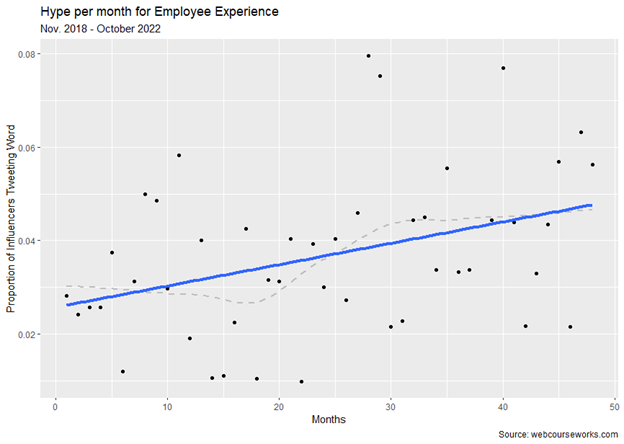
There's a strong human resources bend to the hype curve influencers, and the term "employee experience" has roots in HR. (It also has a strong learning connection, which we'll discuss under the Slope of Enlightenment section later). Often shortened to EX, employee experience is defined by Josh Bersin as "a companywide initiative to help employees stay productive, healthy, engaged, and on track."
For those in the association space, EX can be correlated to MX, member experience.
As EX and MX rise, it naturally leads to the question: Can you buy a pre-designed employee (or member) experience? Perhaps an employee (or member) experience platform? Yes, you certainly can, and we've talked about the rise of member experience platforms before.
The biggest question association professionals must ask themselves as these platforms continue to emerge is how does an MX platform integrate with your existing strategies and systems to create a seamless experience?
Peak of Inflated Expectations
At the Peak of Inflated Expectations, the concept or technology reaches its peak "hype" and is incorrectly regarded as the be-all-end-all solution to problems in the field.
People invest in this technology or concept with vigor, outpacing the reality of the innovation's abilities. This is when we see recurring buzzwords appear across social media, blogs, and even conference presentations.
In 2022, we saw one big trend reach the Peak of Inflated Expectations: Hybrid.
Peak of Inflated Expectations #1: Hybrid Events
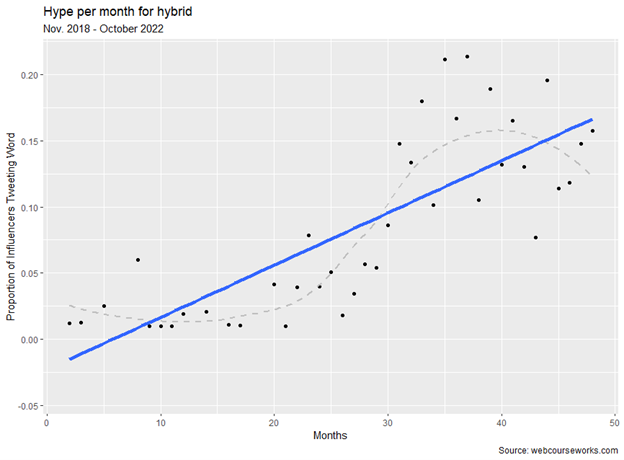
We saw hybrid learning emerge as an Innovation Trigger, likely tied to the increasing use of mixed-modality learning in hybrid work scenarios. But hybrid as a broader concept has become a buzz that may or may not have longevity.
This trend first emerged in 2020 when organizations (especially associations) were forced to cancel in-person events and pivot to virtual. In 2021 and 2022, as restrictions began to recede and we reemerged from lockdown, "virtual" evolved to "hybrid."
The trouble is that no one really got good at hybrid events. It's difficult to design an experience for virtual participants that replicate the in-person experience, and we have yet to land on the perfect blend of hybrid engagement. As this realization dawned, hybrid events, as a trend, lost steam.
Those in the learning space probably aren't surprised to see hybrid learning has emerged as a trend at the same time that hybrid events are retreating. Many associations are ahead of the curve on this one, as they've been designing and delivering blending learning experiences for years. As the trends collided, however, progress was made. Whereas events and education were often siloed "departments," they began to see what they could learn from one another and started to work more closely together.
Trough of Disillusionment
Not long after a concept reaches its peak hype, it hits the Trough of Disillusionment. This is when it becomes evident that the solution isn't a one-size-fits-all fix. Though the trend continues its growth, people begin to lose faith in its utility and drastically scale back their promotion of it.
In 2022, we saw three trends fall into the Trough of Disillusionment: Future of Work, Analytics, and Design Thinking.
Trough of Disillusionment #1: Future of Work
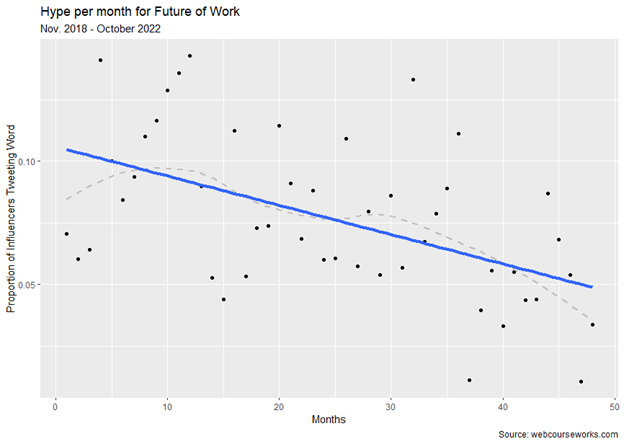
Wait. You may be thinking that you still see the term "Future of Work" all over your feed. How could it have already fallen into the Trough of Disillusionment? Whether or not you believe the trend is receding likely depends on how you define it. And the influencers in our data set think of Future of Work as more than whether or not you return to the office and which technologies we're using for remote collaboration.
In our 2020 Hype Curve Predictions, we looked at Future of Work through the lens of organizations maximizing capacity and productivity by using non-experts to do work previously done by people with highly specialized skill sets. In other words, doing more with less.
Post-pandemic and amid The Great Resignation, however, many companies were forced to put that approach on pause. In a market where talent was scarce and employers no longer had the upper hand, they couldn't realistically ask for more from their workforce. And that appears to be when (this definition) of Future of Work began to recede.
As a macro-trend, however, the idea still resonates. There is a newfound realization that in order to succeed, you must be able to keep pace with accelerating innovation and technology. And that means you must be agile, you must be nimble, and you must be continuously learning. Future of Work was, perhaps, an early version of upskilling.
Trough of Disillusionment #2: Analytics
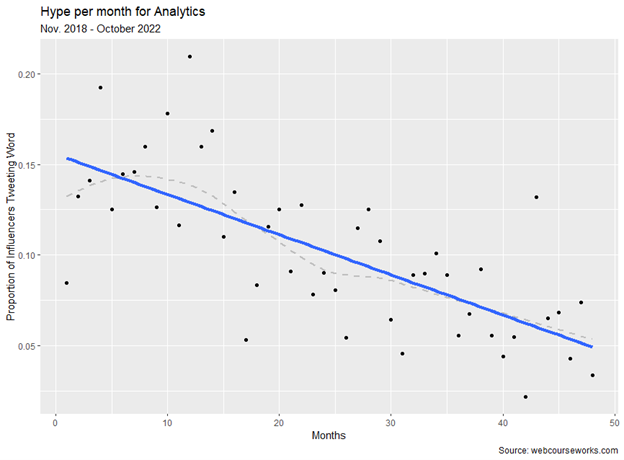
Every organization wants to get better insights from their data, and this is why the analytics trend took hold a few years ago. Does the downward trend mean the insights driven by analytics are any less important? Not at all. This may simply be a case of the inevitable cycle every trending term goes through.
In the case of analytics, pundits have begun to complain that organizations shouldn't have an analytics team—they should have an intelligence team. They suggest that analytics leans too heavily into raw data, which can lead to analysis paralysis. An intelligence team, they say, is more likely to distill the data into actionable strategy.
No matter the name of the team, it's clear there's still a place for the concept. Every business wants and needs analytics to help them better understand their current situation (descriptive analytics), forecast what's going to happen next (predictive analytics), and determine the best course of action to meet their goals (prescriptive analytics). Many organizations have made big strides in descriptive and predictive analytics, and next, we can expect to see people talking about AI to advance prescriptive analytics.
Trough of Disillusionment #3: Design Thinking
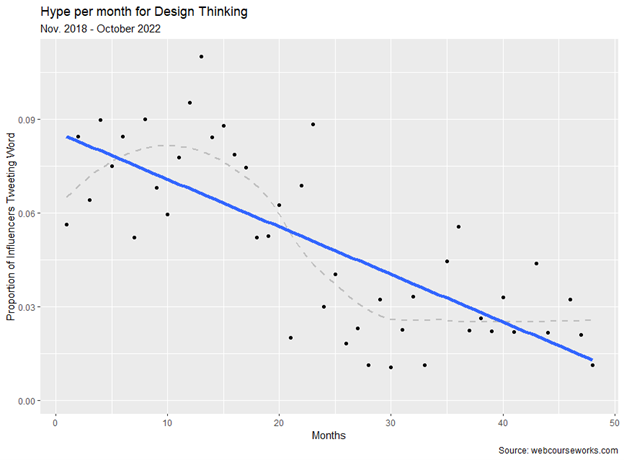
People have used design thinking to refer to the idea of approaching problems the way designers do. It's easy to see why this trend drew buzz in the learning space, where many of our influencers are or have been instructional designers.
The "trend" initially gained traction when it was positioned as a new way of thinking—but it's not a new solution. What it boils down to is that we should be conscious of the end user (employees, members) and purposeful in our design when creating something. Put that way, it sounds like common sense. If nothing else, it was a good reminder to stop and think and has likely helped many of us avoid the pitfalls of implementing a one-size-fits-all solution.
Slope of Enlightenment
At the Slope of Enlightenment, the technology or trend continues to improve and refine, despite decreased hype. Its utility in some scenarios becomes evident and hype begins to increase, but never reaches the levels it hit initially.
In 2022, we saw four trends hit the Slope of Enlightenment: Virtual Reality, Artificial Intelligence, Learning Experience, and Microlearning.
Slope of Enlightenment #1: Virtual Reality
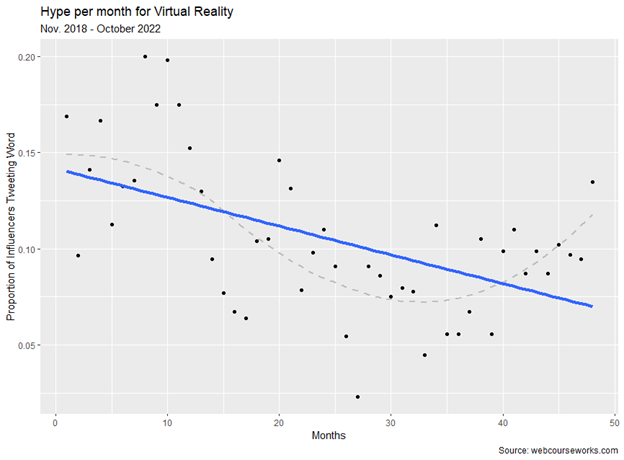
Virtual and augmented reality (VR and AR) are immersive technologies that can create more engaging learning experiences (think virtual flight simulators or interactive 3D environments). These technologies that simulate real-world experiences can also be used to provide training in safer, more controlled environments.
When VR was new and novel, learning professionals were (over)eager to apply it in the education space. The buzz resulted in widespread use of VR in learning scenarios that just didn't make sense. (Do you really need a simulated space to stay up to date on the latest industry rules and regulations? Probably not). The Metaverse added fuel to the fire, leading us to believe everything we do would start to occur in a simulated environment.
Now, we recognize that just because you can use VR doesn't mean you should. People have become much clearer about when virtual reality is beneficial: In any scenario that involves motion or spatial learning. When it aids in learning complex, experience-based tasks. When the real-life version of the learning is infeasible, unsafe, or risky.
Slope of Enlightenment #2: Artificial Intelligence
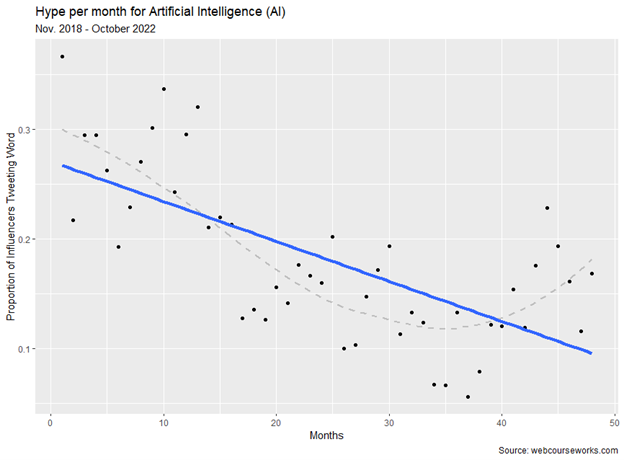
When artificial intelligence (AI) first began to emerge, it was met with quite a bit of skepticism (and considered more than a little creepy). Now, we're becoming more comfortable with the idea of computers performing some of the same tasks we're accustomed to performing ourselves.
In the association space, member needs and preferences are shifting at the pace of technology (in other words, rapidly). Many leaders in charge of learning realize they need to rethink how they've always done things, and they're considering AI to accelerate their learning strategies. AI can be used to create more efficient and effective training experiences, especially when it comes to personalization. It can adapt to a learner's progress, provide meaningful feedback, and generate relevant content to help guide learners on their journey.
Trends like AI and others linked to digital transformation came up in our discussions with association leaders when we probed them for 2023 member experience (MX) predictions. One executive said, "I see associations spending both time and resources to embed thoughtful technology in every area of operations to improve customer engagement and member experience. I believe we will continue to see advancements in artificial intelligence (AI), predictive technology, the internet of things (IoT), and augmented reality."
A quick closing note on AI: You might have expected to see ChatGPT—or the broader concept of generative AI—here. It's not mentioned because our data cutoff was November 2022, just before ChatGPT began trending. We expect to see it show up as an Innovation Trigger in our 2023 report.
Slope of Enlightenment #3: Learning Experience
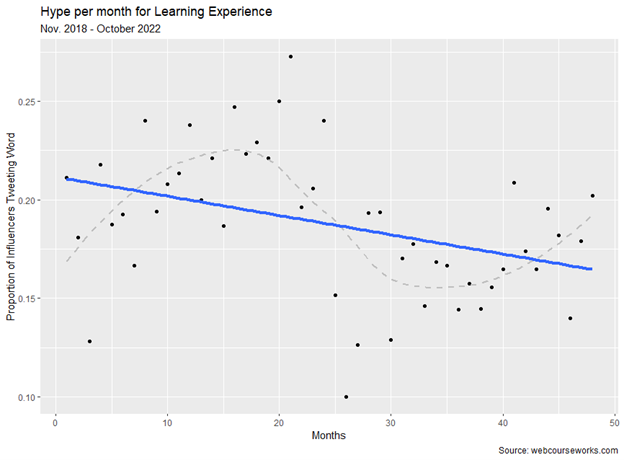
While the concept of employee experience began to emerge as an Innovation Trigger in 2022, learning experience gained a foothold.
A few years ago, Josh Bersin extended his definition of the employee experience to include "knowledge management" (i.e., learning) and coined the term Learning Experience Platform. He used the term to define a specific set of new technologies, but it quickly gained traction as marketing hype and everyone dubbed their platform an LEP. Pretty soon, it became so overused that it began to lose its meaning.
But something positive came from the rise of the so-called Learning Experience Platform: As companies considered their overall employee experience, they also began paying more attention to how they defined and designed (not just monitored) their learning experience. It created a shift, not unlike one we've recently seen in the association space, where leaders are taking a closer look at how they balance investments in staff-facing versus member-facing technologies. Today, there's a greater awareness that using technology to reduce administrative burden is good but leveraging it to enhance the user experience is even better.
Slope of Enlightenment #4: Microlearning
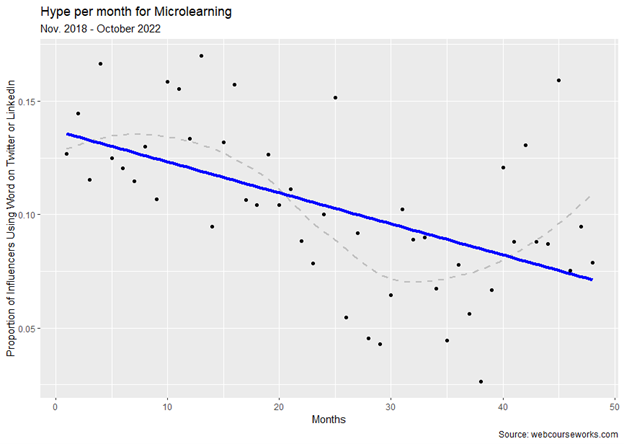
Given the pace of change, learning is rapidly becoming a critical part of many peoples' daily work. But still, the average professional can dedicate just 24 minutes per week to formal learning.
With so much competition for people's time and attention, traditional learning formats have been challenged—and that means associations have had to seek ways to reimagine traditional learning—and their offerings.
Enter microlearning, bite-sized, easily digestible training that can be consumed on the go. Microlearning allows learners to focus on specific skills or knowledge areas. It's especially useful for busy professionals who have limited time to devote to formal training. Microlearning can help alleviate the constraints of time and location, offering flexibility and giving people greater choice.
As microlearning continues to evolve, we'll likely see the technology supporting it advance, too. Learning platforms may be able to organize content and offer up machine-driven recommendations based on role, competency, or other characteristics. In the association space, this may help repurpose and give new life to existing conference content. Imagine being able to package recorded conference sessions, for example, and use intelligent search and suggestions to help members find the tidbits most pertinent to them. This refinement takes the content from hyper-accessible to hyper-relevant.
Plateau of Productivity
At the Plateau of Productivity, actual users of the technology emerge, and buzz reaches a moderate, stable level. Abundant revenue is generated, and it becomes mainstream in the market, seen as useful for actual users rather than as a savior of the field overall.
In 2022, we saw Gamification hit the Plateau of Productivity.
Plateau of Productivity #1: Gamification
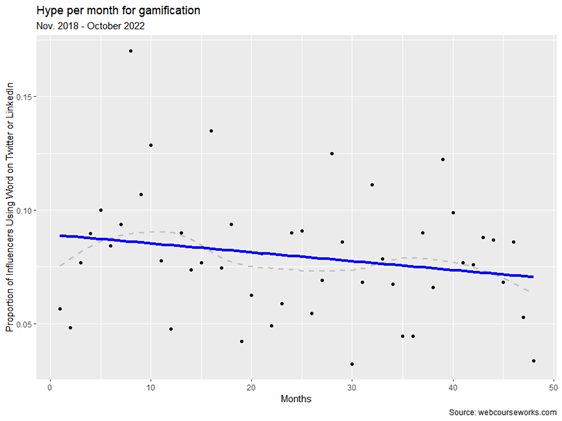
Nearly a decade ago, gamification—the application of gaming features like points, levels, and badges—seemed to have breathed new life into learning. By 2018, we'd become so disenchanted with the idea that we went so far as to call the use of gamification in corporate learning "the worst thing ever." It seems a lot of influencers were in agreement, and by 2020 gamification had fallen firmly into the Trough of Disillusionment.
Now, gamification seems to have reached its Plateau of Productivity. It doesn't elicit groans or cheers from learning professionals. Rather, it's recognized as useful in some scenarios and ineffectual in others. (Think of the cheesy "treasure hunts" you might find in some corporate onboarding and orientation programs compared to the gamified learning you might find in a popular app like Duolingo.)

.png?width=2240&height=1260&name=Learning%20blog%20header%20(1).png)
.png?width=60&height=60&name=Kurt%20Heikkinen%2c%20Forj%20CEO%20(1).png)

